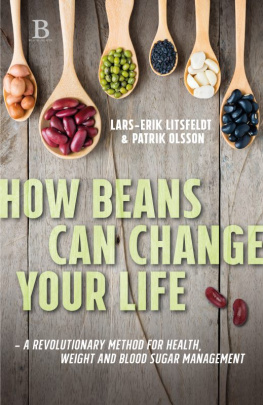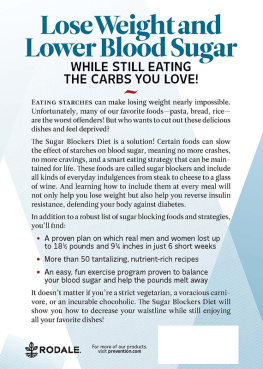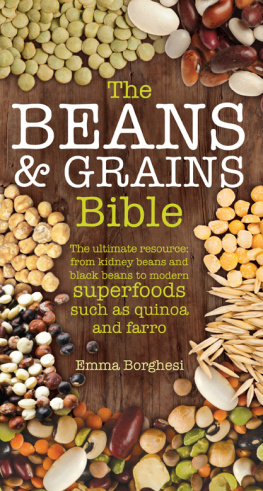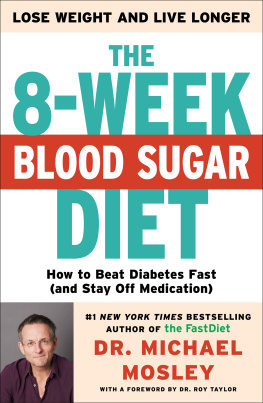How beans can change your life A revolutionary approach to health, weight and blood sugar
Lars-Erik Litsfeldt & Patrik Olsson
To Marie Nehagen
Marie your greatest dream was to write a cook book for diabetics. Unfortunately, this did not come to pass. I promised to pick up where you left off and fulfill your dreams. This book is my contribution and tribute to you. Despite the fact that this book is not as comprehensive as you might have liked, I think you would have been proud!
Patrik Olsson
How Beans Can Change your Life
www.bladhbybladh.se
Copyright Lars-Erik Litsfeldt & Patrik Olsson 2017
Published by Bladh by Bladh AB
Cover: Anders Timrn
Photos: Maria Ahlberg
ISBN 978-91-88429-58-2
E-book production: Axiell Media, 2017
High blood sugar and consequent high insulin levels are bad for you. Period.
We would like to thank:
Ralf Sundberg, who took the time to read the script and write the foreword.
Erik Edlund, for sharing the content of your close to encyclopedic brain.
Maria Ahlberg, for exposing yourself to so many experiments and helping so much with the practical work.
Annika Bladh, the publisher, who dared to take our idea and turn it into reality.
Lars-Erik & Patrik
Foreword
Lars-Erik Litsfeldt has written a very readable and thought-provoking book, this time along with debutant Patrik Olson. The subject is mastered by both very well: How should diabetics eat to feel as good as possible, and minimize the risk of long-term complications? The subject also concerns the many of us who have the tendency to be overweight and obese ourselves, or in the family, because this also predisposes us to the so-called diseases of affluence.
During my time as a medical student in the 70s, I got a summer replacement as a nurse at the medical clinic in Nssj. When tasks so allowed, which was often, I was invited to sit with the senior physician during patient dialogues and examinations, something called auscultation. Every Tuesday it was diabetes consulting. The patients first in a fasting state went to the laboratory to take urine and blood tests, and then came back at 11 o'clock after eating breakfast. After the weigh in, it was time to see the doctor.
Slightly less than half of the patients got scolded for not behaving well with respect to eating habits.
"Did you have too many carbs again!?" How many slices of bread a day? Oh, four. Far too much. And potatoes? But don't you remember you are just allowed to have one potato? You must eat other vegetables. And milk? Five glasses when you know you can only have one? No wonder your sugar levels are all wrong. Now go home and pull yourself together and then I want to see you in four weeks!
What I remember especially is that type 2-diabetics never were on insulin. It was considered to be a kind of misconduct to give insulin at this diagnosis, since this category of patients without exception had high insulin production. The goal of insulin treatment for those with type 1 diabetes was that insulin doses would be as low as possible with regard to blood glucose levels, as high insulin doses often lead to fluctuating blood glucose levels. Insulin treatment can be dangerous because really low blood sugar can produce coma and risk of brain damage if repeated, and the risk of other complications increases as well. So even here the diet was most important, and it was through a reduced carbohydrate intake that the goal was to be achieved. It was clear that children and adolescents from less favorable socioeconomic conditions usually had poor blood sugar control.
During my time as an assistant physician in Kalmar in the late 70s and early 80s, I rarely met patients who would, for example, be hospitalized for a rupture surgery, which, on the issue of past illnesses, said they "had a touch of diabetes," but that it had passed after being prescribed dietary changes and more exercise.
In the early 1990s, I returned to Karolinska University Hospital in Huddinge after a couple of years as a transplant surgeon and researcher in the United States. In addition to transplantation of livers, the far more common activity was kidney transplantation. About 25% of patients in dialysis waiting for a kidney have diabetes and renal failure is a complication of this disease. In addition, pancreatic transplantation was performed on type 1 diabetics, in the hope that they would release insulin.
One afternoon I saw a newly transplanted diabetic eating a cinnamon bun with coffee. I asked the nurse who served if she possibly had not made a mistake. Oh, no.. This was entirely according to the routine, was the answer. How had it escaped me, the routines were changed in this way, I asked myself. Sugar and white flour will raise blood sugar and worsen the diabetic status and then the new kidney will be hurt. I confronted the responsible diabetes surgeon. He responded that new guidelines were introduced because there have been so many new aids in the diabetes field, that patients can use their own blood glucose meters and that new insulin types allow for more accurate treatment. "We the diabetes doctors have become so much better at insulin dosage and in prescribing tablets and there are also new varieties. So why would not diabetics be allowed to live like everyone else and have a coffee and a cinnamon bun?"
Eventually it turned out that this method didn't work. Large studies in the UK and the United States show that no type 2 diabetics turn healthy on the high-carbohydrate diet that most doctors and dieticians advocate. The strange thing is that everyone seems to have forgotten how it was before and that so few question the dietary advice that "expert groups" convey.
Lars-Erik Litsfeldt was one of the pioneers of the grassroots work that led to the so-called low-carbohydrate movement. As a type 2 diabetic, he had his own experience of how bad one can be as a diabetic on conventional treatment, and how much better one can be when he takes his destiny into his own hands, and does what is logical. One reduces the food that led to the disease and also causes it to progress. You remove what raises blood sugar and eat what does not. Simply said, LCHF-diet instead.
The research supports this, but doctors prescribe medications and do not talk about diet, while dieticians prescribe a diet that requires more medications without understanding the greater whole. Between them there seems to be sharp dividing lines. But hopefully this will change. The work of the grass roots and research win in the long-run.
LCHF is good, but new research indicates that what's good can be done even better. This is where this book comes in. In recent years, our awareness of the intestinal flora's significance for our health has increased significantly. A book that illuminates this in an entertaining way is Giulia Enders' The Inside Story of Our Body's Most Underrated Organ . Another very good book is Martina Johansson's Magstarkt .
The intestinal flora is influenced by what we eat. And what the bowel's bacteria do is not just about how it feels in the stomach, it affects our appetite, our well-being and the risk of excess weight and diabetes. Transplantation of intestinal bacteria from slim persons to obese persons has produced weight loss in these and vice versa.














